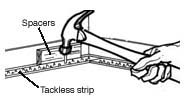|
carpet
installation tips

Carpet Installation Tips
Carpet installation is a
service your carpet retailer provides for a fee that is additional to the
cost of the carpet. Having your carpet installed right is critical: proper
installation insures that the carpet will look good and deliver the best
performance.
Here are carpet installation pointers:
Installation: A
quality carpet installation is critical to the performance of your carpet and
will protect your indoor air quality. When having your
carpet installed, the Carpet and Rug Institute advises obtaining the
services of an installation contractor who adheres to the Standard for
Installation of Commercial Carpet, for all aspects of the
installation.
Before Installation: Have a clear understanding of the services the retailer will provide and be
aware of those that you must handle. For example, there may be an
additional charge to move your furniture. Discuss with the retailer who
will remove the existing carpet and cushion and be responsible for
disposal. Placement of seams is important. Ask that seams be placed in
less visible areas. Request that the installer follow the instructions
from the carpet manufacturer and/or those set forth in the Standard for
Installation of Residential Carpet, accepted by the industry.
Don’t expect seams to be invisible.
Before the installers arrive, complete
other remodeling projects intended in the room, such as painting and
wallpapering. Vacuum the old carpet to avoid the possibility of airborne
dust and dirt. After the carpet and cushion are removed, vacuum the
sub-floor.
When Carpet is Delivered: Check its texture, color, and style; make sure there are no visible
defects before installation. Be sure the installer will
adhere to the Standard for Installation of Residential Carpet. Among other things, it requires for proper installation that carpet must
be power-stretched to minimize wrinkling and rippling. Seam edges must
be sealed with appropriate adhesive to prevent delamination and edge
ravel. Buying your carpet from an authorized "Seal of Approval"
retailer will ensure a professional installation.
During Installation: New, thicker
carpet may prevent doors from swinging clear and free. The installer will
remove the doors and re-hang them if possible. If the doors do not clear,
arrange to have them trimmed. It is your responsibility to provide an
adequate supply of fresh air during installation. Open windows and doors,
use an exhaust fan, or operate the fan of your heating or air conditioning
system.
After Installation: Vacuum
your carpet to remove loose fibers. You may notice a slight new carpet
smell, which should dissipate quickly. Ventilate the area for 48 to 72
hours. If you are unusually sensitive to odors or allergy-prone, you may
want to avoid the installation area during this period. If you have any
questions about this, contact your retailer.
| In the
months following installation, you may notice these
characteristics: |
- SHEDDING—the shedding of
loose fibers is normal and should subside with regular
vacuuming.
- SPROUTING—if a single tuft
extends beyond the carpet’s surface, simply clip it off. Do
not pull it out.
- PILE REVERSAL OR SHADING—a
color change that seems to occur in various parts of the
carpet, caused by light being reflected in different ways, as
pile fibers are bend in different directions. This is not a
defect but a characteristic of plush carpet.
- WRINKLING—if ripples
persist, call your retailer. It may be necessary to
professionally re-stretch the carpet.
|
| Common
sense recommendations for installing new carpet: |
- Install a carpet with CRI's
Indoor air Quality Carpet Testing Program label, indicating
that the product type has been tested and meets the low TVOC
emissions criteria.
- When the carpet is to be glued
down (not usually in residential applications), ask the
installer to use an adhesive displaying the CRI's Indoor Air
Quality Adhesive Testing Program label, indicating that it has
been tested and meets the low TVOC emissions criteria.
- Vacuum the old carpet prior to
removal and the floor after the old carpet and cushion has
been removed to minimize airborne dust and other particulates.
- Ventilate with fresh air (open
windows, operate a fan, and/or run the fan of the heat/air
system continuously) during the removal of the old carpet and
the installation of the new carpet, and for 48 to 72 hours
after installation.
- Use a professional installer
and confirm that the minimum industry-accepted installation
standards are followed.
- Those who consider themselves
unusually sensitive or prone to allergic reactions may wish to
leave the premises while the old carpet is being removed and
the new carpet installed, and for 48 to 72 hours afterward.
|
In general, follow the same common sense
ventilation precautions used when painting, wallpapering, or renovating
any area of the home.
© 2008 FloorBiz, Inc. All Rights Reserved
Flooring |
Flooring Guide |
Flooring Info |
Flooring Forum
| |




